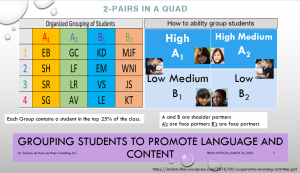7 Back-to-School Tips for the STEM Teacher
Well, it is that time of the year again when students and teachers return to school for another year of learning, explorations, excitement, and, for some, the unknown: the unknown of a new culture, new friends, new curriculum, and new language. Today’s blog post is about how to create a welcoming environment in your STEM classroom that will help the multilingual learner (MLL) who is new to the country—or just to your context—adjust to a new way of learning.
Understanding the Stages of Culture Shock
Culture shock is one of the four stages of cultural accommodation (euphoria, culture shock, acceptance, and assimilation/adaptation). Understanding that these stages exist will help you in understanding and even identifying actions or attitudes that your newcomer MLLs may exhibit in the classroom.
The stages and brief explanations of culture shock are:
1. The Honeymoon Stage: MLLs are very positive, curious, and anticipate new and exciting experiences. The may even idealize the host culture.
2. Irritability and Hostility: MLLs may start to feel that what is different is actually inferior. The host culture is confusing or the systems are frustrating.
3. Gradual Adjustment: MLLs feel more relaxed and develop a more balanced, objective view of their experience.
4. Adaptation of Biculturalism: MLLs feel a new sense of belonging and sensitivity to the host culture.
5. Reentry Shock: MLLs return to their home country for a visit and it isn’t what they expected it to be.
I have heard from many teachers that it is Stage 2 that they wished they were more aware of earlier in their career. In Stage 2, it’s a small step from students saying that the new culture does things in “a different” way to saying that it does things in “a stupid” way. MLLs may blame their frustrations on the new culture (and its shortcomings) rather than on the adaptation process.
Teachers with MLLs going through this stage often interpret their students’ actions as being defiant, or they believe that the material is too rigorous for the students and so they are “acting out.” As a result, teachers often discipline the student for their negative actions or recommend them for a lower class or intervention services.
Making Your STEM Classroom a Welcoming Place
So, how can you make your STEM classroom a welcoming place for your MLLs—both newcomers and those just new to your classroom? Here are a few simple ideas:
1. Offer One-on-One Assistance
Just as there are stages of culture shock, there are levels of language acquisition—and the first stage is the silent stage. This means that the chances of an MLL speaking when they’ve first arrived in the country is very slim. So, take the time to work one-on-one with any newly arrived MLLs whenever you can. Give MLLs the option to draw their responses rather than speak them. Better yet, you can ask yes/no, or true/false questions to gauge your MLLs’ levels of understanding. Use short, simple sentences and use visuals as often as possible.
2. Assign a Buddy
Any buddy can be beneficial, but if there happens to be a student who speaks the same language as an MLL, that is an even better match. This buddy has to be a student who is patient and wants to help the MLL.
3. Use Visuals for Instructions, and Model Tasks
As you are explaining the instructions for a task, use visuals to guide the students. Modeling the steps is also a great visual. This will help MLLs comprehend and remember the steps to the assignment.
4. Research Where Your MLLs Are From and Connect Your Content
Building a STEM challenge that connects to your MLLs’ home country or countries benefits not only the MLLs, but it also gives the other students in your class an opportunity to learn something about where their classmates are from. This can be exciting for both the MLLs and the native speakers. You can use books, characters, and images that are familiar to the MLLs as a part of your lesson’s STEM challenge or activity.
5. Offer a Variety of Interaction Types
MLLs must be provided the opportunity to practice listening, speaking, writing, and reading in a variety of interactions: one-on-one, small group, peer grouping, whole group, with the teacher, and individually. Each interaction requires a different set of vocabulary terms and level of language sophistication. When working one-on-one or in small groups, a student can point to words or objects to help explain what they did or are speaking about. This allows for less specificity in word choice. When presenting to the class or writing reports, vocabulary and word choice becomes more targeted and specific. Keep this in mind when giving assignments to MLLs because their level of language proficiency should guide the tasks and the criteria with which you will grade them.
6. Use Two Pairs in a Quad Grouping
Teachers play a key role in structuring activities so that MLLs have regular opportunities to share their ideas and funds of knowledge and to practice reading, writing, listening, and speaking the language. “Two Pairs in a Quad” is a phrase I coined at the 2022 TESOL convention; it’s a powerful strategy that took the room by storm. This grouping provides the teacher with a way to teach in a classroom with many MLLs at different levels of proficiency while still maintaining rigor.

Grouping proficient/fluent speakers and MLLs creates an environment where the MLLs are seen as competent community members and contributors in the classroom, even when their English is not proficient. Below is an example of how a teacher can group students into what I call communities. This structure provides the students with a small group (or team) in which to collaborate and ask questions as opposed to a full classroom, which can be intimidating and uncomfortable. The colorful table on the left in the picture show the groups with student initials. The chart to its right represents the two pairs in the quad for each group.
7. Learn How to Properly Pronounce Your MLLs’ Names
Do not be embarrassed to ask your students how to pronounce their names. Names are part of a person’s cultural and personal identity, so it is important that we take the time to learn them correctly. I am sure that your students will appreciate that you care enough to ask them for the right pronunciation.
I am hopeful that these seven tips and the explanation of culture shock and its stages provide you with some great information as you begin the school year. Be sure to share with me any other tips and strategies that you found made a difference in your STEM classroom for your MLLs!

